Red light therapy strengthens your blood vessels through multiple powerful mechanisms. When the red and near-infrared light penetrates your tissues, it triggers increased production of nitric oxide, which relaxes and widens your blood vessels. Your cells' mitochondria absorb this light, boosting ATP energy production and powering cellular repair. This enhanced energy drives the formation of new blood vessels through angiogenesis while stimulating fibroblasts to produce more collagen for vessel strength. The therapy also increases blood flow, delivering essential oxygen and nutrients to your tissues. Understanding these complex interactions reveals why this therapy has become a game-changer for vascular health.
The Science Behind Red Light
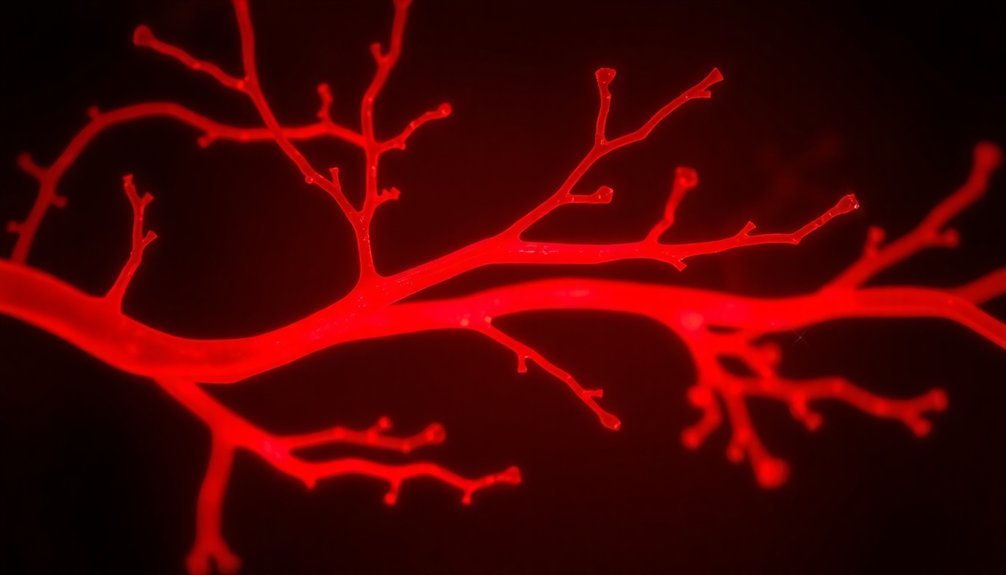
The process doesn't stop there. Your body responds by creating more mitochondria through a process called mitochondrial biogenesis, while also rebuilding cytochrome c oxidase, a vital enzyme for cellular energy production.
This enhanced cellular energy powers your body's natural healing processes, reduces inflammation, and supports tissue repair. Healthy blood flow helps transport essential nutrients and oxygen throughout your system. It's a non-invasive approach that works with your body's natural mechanisms to improve vascular health and overall cellular function.
Nitric Oxide Production Basics
When you receive red light therapy, your body triggers the release of nitric oxide through both enzymatic and non-enzymatic pathways, particularly at the cellular level of your blood vessels.
Your body's increased nitric oxide production during treatment works directly to relax vascular smooth muscle, leading to improved blood flow throughout the treated areas.
You'll experience enhanced circulation as the nitric oxide helps your blood vessels expand, allowing for better oxygen delivery to your tissues. This process also supports immune cell communication, helping to strengthen your body's natural defense systems.
NO Release During Treatment
During red light therapy sessions, nitric oxide production follows specific biological pathways that start with specialized enzymes called nitric oxide synthases (NOS). These enzymes use L-arginine, oxygen, and NADPH to create nitric oxide and L-citrulline. The therapy's light wavelengths penetrate deep into tissue layers to activate these crucial enzymes.
You'll find three types of NOS enzymes in your body: endothelial (eNOS), neuronal (nNOS), and inducible (iNOS), each working in different cells with specific functions.
When you're undergoing red light therapy, the treatment stimulates these NOS enzymes to release more nitric oxide, which then causes your blood vessels to relax and widen. This process requires several cofactors, including calmodulin, FMN, FAD, and tetrahydrobiopterin, to work effectively.
As your blood vessels dilate, you'll experience improved circulation, leading to better oxygen and nutrient delivery throughout your body.
The nitric oxide released during your treatment acts quickly but has a short half-life, making it an ideal signaling molecule. You'll benefit from its localized effects, including reduced inflammation, enhanced cellular repair, and improved nerve function.
This targeted release helps protect your blood vessels while promoting natural healing processes in the treated areas.
Blood Flow Enhancement Pathways
Understanding nitric oxide production starts with a fundamental chemical reaction in your body: L-arginine combines with oxygen through nitric oxide synthases (NOS) to create nitric oxide and L-citrulline. This process requires specific cofactors, including NADPH, tetrahydrobiopterin, FMN, and FAD, to function properly. The reaction is heavily influenced by calcium-calmodulin binding, which regulates enzyme activity.
Your blood vessels rely on three types of NOS enzymes, but eNOS is particularly essential as it's responsible for maintaining your baseline NO production in vascular endothelium. When NO is released, it triggers smooth muscle relaxation in your blood vessels, leading to vasodilation and improved blood flow.
You'll experience better circulation as NO also prevents platelets from sticking together and stops white blood cells from adhering to vessel walls.
Red light therapy enhances these pathways by stimulating NO production, which directly impacts your vascular health. When you combine this therapy with exercise and proper nutrition, you're creating ideal conditions for NO synthesis.
This matters because impaired NO production is linked to serious conditions like atherosclerosis, diabetes, and hypertension. The relationship between NO and reactive oxygen species in your vascular system is delicate, and maintaining proper balance is essential for cardiovascular health.
Blood Flow Enhancement Mechanisms
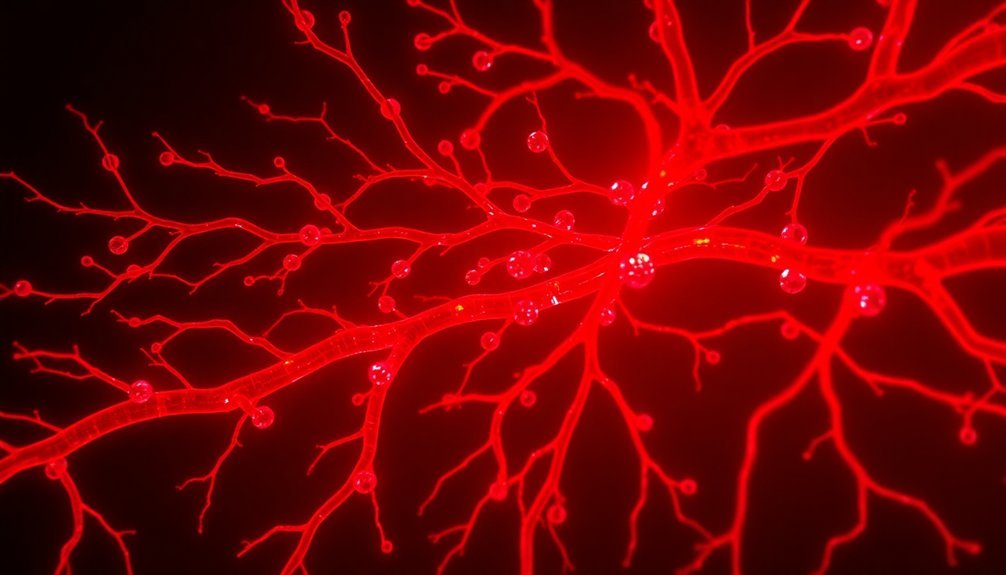
When you undergo red light therapy, it triggers nitric oxide production through multiple pathways in your blood vessels, starting a cascade of cellular responses.
Your vessels then undergo a controlled dilation process as smooth muscle cells relax, creating more space for blood to flow.
This expansion directly enhances your microcirculation, letting more oxygen and nutrients reach your tissues through the smallest blood vessels in your body.
NO Production Pathways
In response to blood vessel regulation needs, nitric oxide (NO) production occurs through two distinct pathways: the endogenous pathway and the enterosalivary pathway. Your body uses these pathways to maintain healthy blood flow and vessel function.
| Endogenous Pathway | Enterosalivary Pathway |
|---|---|
| Relies on nNOS and eNOS enzymes | Depends on dietary nitrates |
| Requires L-arginine as substrate | Needs healthy oral microbiome |
| Activated by acetylcholine & shear stress | Converts nitrates to nitrites to NO |
| Declines with age | Remains effective regardless of age |
| Stimulated by exercise | Enhanced by nitrate-rich foods |
You can boost NO production through several methods. L-arginine supplementation combined with antioxidants like vitamin C enhances the endogenous pathway, while consuming nitrate-rich foods supports the enterosalivary pathway. Red light therapy stimulates both pathways by enhancing cellular processes and promoting NO release. Additionally, compounds from garlic act as hydrogen sulfide donors, further supporting NO production. Your blood vessels respond to this increased NO by activating soluble guanylate cyclase, which triggers smooth muscle relaxation and improves blood flow through multiple mechanisms, including calcium regulation and potassium channel activation.
Vessel Dilation Process
Blood vessel dilation relies on a complex interplay of mechanical, hormonal, and metabolic factors working together to enhance blood flow throughout your body.
When your blood vessels dilate, smooth muscle cells relax, allowing the vessels to widen and reduce vascular resistance. This process increases blood flow and delivers more oxygen and nutrients to your tissues.
Your body's natural dilation mechanisms respond to various signals, including hormones, neurotransmitters, and metabolic byproducts. During exercise, for example, increased CO2 levels and metabolites like lactate trigger vasodilation to meet your tissues' heightened oxygen demands.
Red light therapy can enhance this natural process by stimulating nitric oxide production, a vital molecule for blood vessel dilation.
- Smooth muscle relaxation decreases vascular resistance and increases vessel diameter, allowing more blood to flow through
- Local metabolic factors, such as CO2 and lactate, signal your vessels to dilate during physical activity
- Therapeutic interventions like red light therapy work alongside your body's natural mechanisms to improve blood flow
This coordinated process guarantees that your tissues receive adequate blood supply, supporting overall health and recovery while maintaining effective circulatory function.
Microcirculation Flow Effects
Microcirculation flow depends on several sophisticated mechanisms working in harmony to optimize your blood delivery at the smallest vessel level. When you undergo red light therapy, it triggers multiple pathways that enhance this intricate system.
Your blood vessels respond through mechanical stimulation, where wall shear stress prompts flow-mediated dilation, while key vasodilatory factors like nitric oxide and prostaglandins facilitate vessel expansion.
You'll benefit from the therapy's ability to activate specific regulatory pathways, including eNOS and COX, which produce vital vasodilators. During this process, your smooth muscle cells relax through cGMP and cAMP mediation, increasing blood flow through the smallest vessels.
Local metabolic factors, such as CO2 and adenosine, further contribute to this vasodilation effect.
What makes red light therapy particularly effective is its ability to stimulate nitric oxide production while reducing inflammation in your microvessels. This enhancement of microcirculation supports better oxygen delivery to your tissues and improves cellular repair processes.
The therapy's impact extends beyond immediate blood flow improvements, helping manage conditions like peripheral artery disease and supporting better muscle recovery through enhanced microvascular adaptation.
Cellular Repair and Growth
Through targeted exposure to red and near-infrared light, cells undergo remarkable repair and growth processes that boost overall tissue health.
When you use red light therapy, it triggers fibroblasts to produce more collagen while simultaneously increasing ATP production, which powers cellular repair mechanisms. This enhanced cellular energy drives the formation of new blood vessels through a process called angiogenesis.
Your body's natural healing abilities get supercharged as the therapy increases nitric oxide generation and calcium influx into cells. These processes work together to stimulate the production of VEGF by endothelial cells, which directly supports new blood vessel formation and improved circulation.
- Red light therapy activates multiple cellular repair pathways, boosting collagen production and ATP generation for ideal tissue healing.
- The treatment enhances blood flow and oxygen delivery to cells, creating an ideal environment for tissue regeneration.
- Your body's natural growth factors increase, leading to stronger, healthier blood vessels and improved microcirculation.
These cellular improvements don't just affect your blood vessels – they extend to surrounding tissues, promoting faster wound healing, reduced inflammation, and better overall vascular health.
Strengthening Your Vascular System
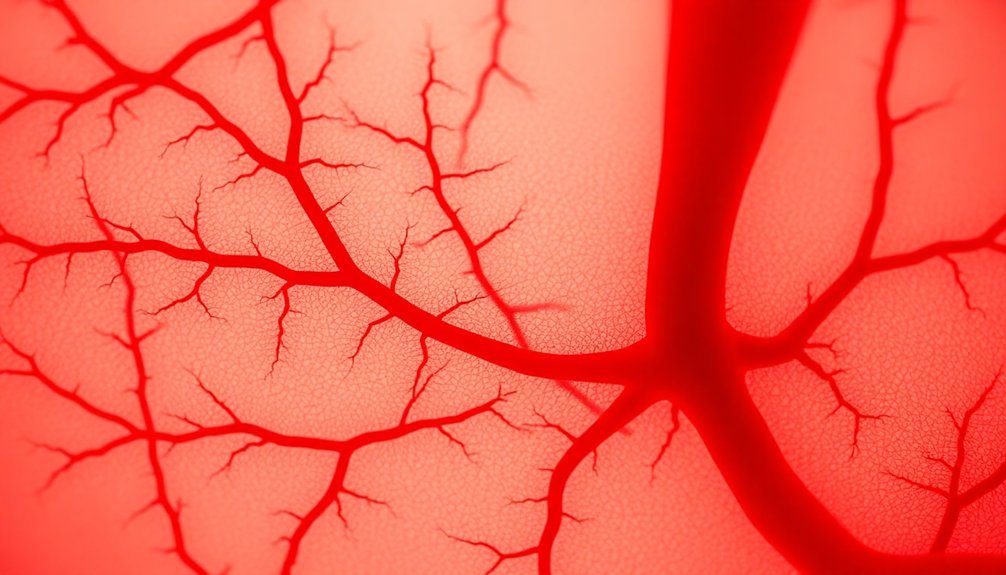
Several practical strategies can help you build and maintain a robust vascular system while maximizing the benefits of red light therapy. Start by incorporating regular physical activities like walking or swimming into your daily routine, as these exercises naturally boost circulation.
When you pair exercise with red light therapy sessions, you'll enhance vasodilation and improve oxygen delivery to your tissues.
Your diet plays a vital role in vascular health. Focus on consuming fiber-rich foods and increasing your intake of vitamin C and D. You'll want to reduce sodium consumption while adding omega-3-rich green vegetables to support healthy veins.
Don't forget to stay well-hydrated throughout the day.
Make smart lifestyle adjustments by taking regular breaks from prolonged sitting or standing. If you're dealing with poor circulation in your legs, try wearing compression stockings and elevating your legs during breaks.
You'll also strengthen your vascular system by maintaining a healthy weight and getting adequate sleep. For the best results, time your red light therapy sessions between exercise periods – this combination enhances nitric oxide production and improves microcirculation in your capillaries, leading to better overall vascular function.
Mitochondrial Power in Blood Vessels
Every blood vessel in your body relies on mighty mitochondria – the cellular powerhouses that generate essential ATP energy. Your blood vessels depend on these microscopic engines to maintain their health, regulate inflammation, and control cell death.
When your mitochondria aren't functioning properly, you'll experience increased inflammation, premature aging, and potential cardiovascular issues.
Your vascular health directly connects to mitochondrial performance. When these powerhouses become damaged, you'll see a cascade of problems, including:
- Increased inflammation in vessel walls leading to plaque formation
- Higher levels of harmful reactive oxygen species causing DNA damage
- Accelerated aging of blood vessel cells through premature senescence
You can protect and enhance your mitochondrial function through lifestyle changes. Weight loss and regular physical activity improve your mitochondrial performance, which strengthens your blood vessels.
Think of your blood vessels as a complex network that needs constant energy to function – when mitochondria work efficiently, they help prevent calcification, reduce inflammation, and maintain proper blood flow. This delicate balance relies heavily on these tiny but powerful organelles working at their peak performance.
Research Validating Red Light Benefits
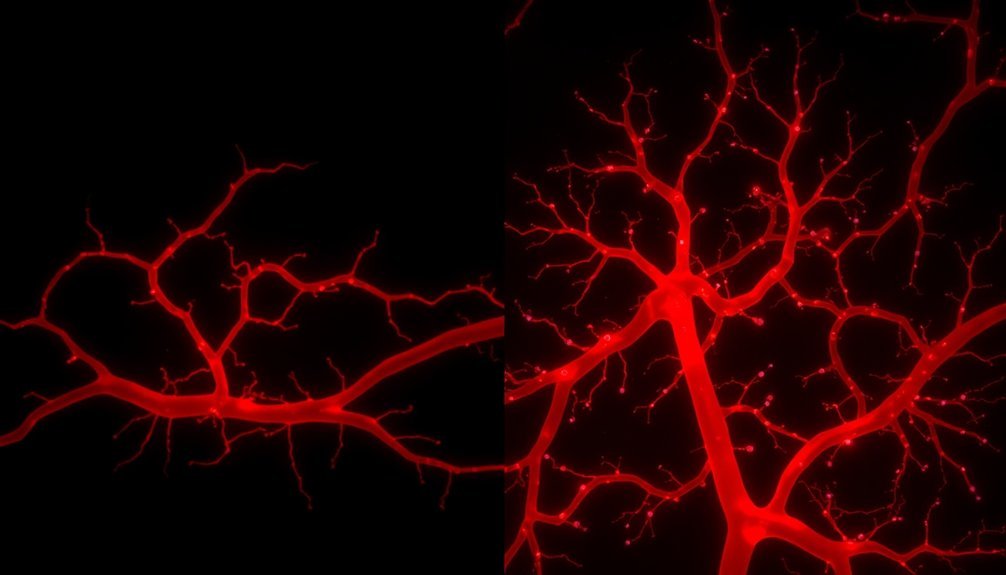
While mitochondrial health plays a vital role in blood vessel function, scientific research has confirmed that red light therapy offers additional powerful benefits for vascular health.
Clinical studies show that red light exposure triggers the production of nitric oxide, a key compound that widens your blood vessels and improves circulation for up to 30 minutes after treatment.
You'll find that this therapy's impact extends beyond simple vasodilation. Research validates that red light therapy enhances oxygen and nutrient delivery throughout your body while reducing inflammation that can restrict blood flow. The evidence is particularly compelling for conditions like peripheral artery disease and diabetic vascular neuropathy, where improved circulation is essential for symptom relief.
NASA-backed research has demonstrated red light therapy's effectiveness in treating various vascular conditions without invasive procedures. Studies show that light-activated compounds can create natural vascular scaffolds, providing physical support while decreasing inflammation.
These findings are especially significant because they're supported by ongoing clinical trials testing both safety and effectiveness. The research consistently shows that red light therapy improves microcirculation in your smallest blood vessels, making it a validated option for treating chronic venous insufficiency and supporting muscle recovery.
Optimizing Treatment Sessions
When you're using red light therapy for blood vessel health, timing your exposure correctly is essential, with sessions lasting 10-20 minutes and occurring 3-5 times weekly.
You'll want to position your device 6-12 inches from the target area, ensuring the light reaches deeper tissues where blood vessels need support.
For maximum benefits, you can gradually increase your exposure time as your body adapts, while maintaining consistent treatment schedules that work with your daily routine.
Timing Your Light Exposure
Getting the most out of red light therapy depends heavily on timing your treatment sessions effectively. While you can use red light therapy at any time of day, certain periods may offer specific advantages based on your goals.
Morning sessions between 8:00 AM and 11:00 AM coincide with peak ATP production, making them ideal for boosting energy levels and enhancing pre-workout performance.
Evening sessions, on the other hand, can help regulate your sleep cycle by mimicking sunset and supporting natural melatonin production.
The key to success isn't just about choosing the right time—it's about maintaining consistency. You'll see better results by sticking to regular sessions 3-5 times per week for 10-20 minutes each, rather than focusing solely on perfect timing.
- Morning treatments (8:00-11:00 AM) optimize energy production and athletic performance
- Evening sessions support sleep quality and recovery mechanisms
- Pre-event treatments should be scheduled 3-6 hours before physical activities
Consider your personal schedule and goals when planning sessions. If you're using therapy for athletic performance, morning sessions might work best. For sleep enhancement, evening treatments could be more beneficial, but be mindful that bright red lights close to bedtime might be stimulating for some individuals.
Positioning For Maximum Benefits
Proper positioning can make or break the effectiveness of your red light therapy sessions. To enhance your treatment, you'll need to maintain a consistent distance of 6-12 inches between the device and your target area. This spacing guarantees the light penetrates your tissues at the ideal depth for stimulating blood vessel growth and circulation.
If you're using a panel device, you'll get the best results by positioning yourself in a seated position, especially when targeting your face, neck, or torso.
For more targeted treatments, consider using specific wraps designed for joints like knees or elbows. These wraps offer better flexibility and convenience, particularly if they're wireless, allowing you to move freely during treatment.
Don't forget to protect your eyes with appropriate eyewear during sessions, and make sure your treatment space is clean and dust-free.
Whether you're using a handheld device, panel, or wrap, follow the manufacturer's specific instructions for positioning and treatment duration. Remember to stay consistent with your positioning across sessions – this helps guarantee you're treating the same areas effectively each time for maximum blood vessel development.
Long Term Vascular Health
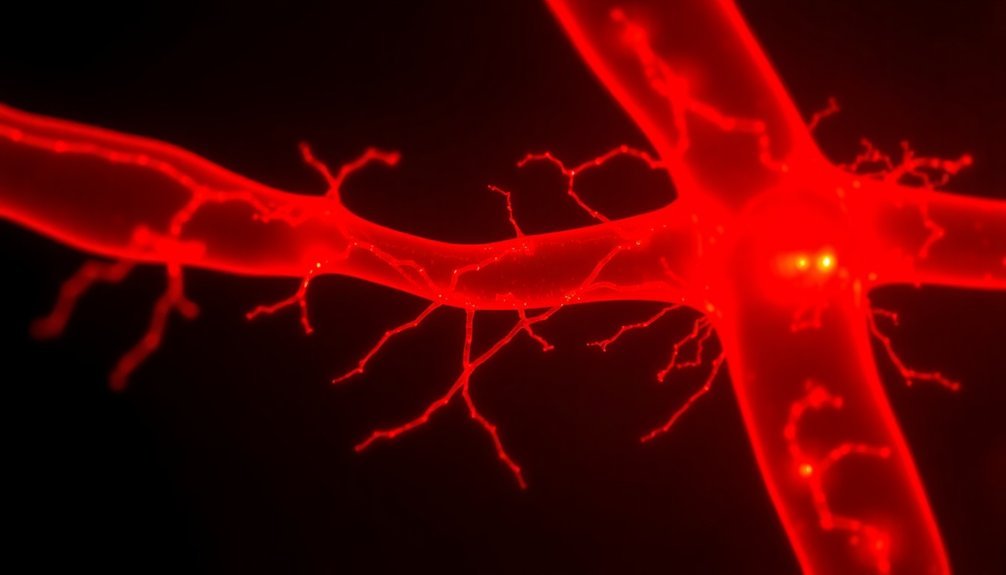
Maintaining long-term vascular health requires a multi-faceted approach that combines movement, therapeutic interventions, and lifestyle changes. When you integrate red light therapy into your wellness routine, you'll stimulate nitric oxide production and improve blood flow throughout your body. This therapy enhances microcirculation and promotes the formation of new blood vessels, while simultaneously reducing inflammation.
To maximize your vascular health benefits, you'll want to combine red light therapy with other proven interventions:
- Reduce your sitting time and take regular movement breaks – even an hour less of sedentary behavior daily can substantially improve your flow-mediated dilation and cerebral blood flow.
- Incorporate both aerobic exercise and strength training into your routine to keep arteries flexible and reduce plaque buildup.
- Add regular sauna sessions to your wellness plan to enhance endothelial function and lower blood pressure.
The synergistic effects of these interventions can dramatically improve your long-term vascular health. Regular movement keeps your arteries wide and flexible, while red light therapy enhances blood vessel formation and function. When combined with sauna bathing, you're creating a powerful foundation for cardiovascular wellness that can reduce your risk of heart disease and stroke.
Athletes and Blood Flow
Blood flow plays a pivotal role in athletic performance and recovery. As an athlete, you'll benefit substantially from therapies that enhance circulation, particularly red light therapy (RLT). RLT increases blood flow by stimulating nitric oxide production, which relaxes and widens your blood vessels, delivering more oxygen and nutrients to your cells.
You can maximize your recovery by combining RLT with blood flow restriction training (BFRT). While BFRT temporarily limits blood flow to specific areas during low-load exercises, it triggers growth hormone release and lactate production, promoting muscle growth without stressing damaged tissues.
This combination proves especially beneficial if you're recovering from injuries or dealing with arthritis.
To optimize your blood flow, you'll want to pair these therapies with traditional methods like physical therapy, targeted exercises, and massage. You should also avoid factors that restrict blood flow, such as smoking, excessive caffeine, or poor dietary choices.
Recovery Through Better Circulation
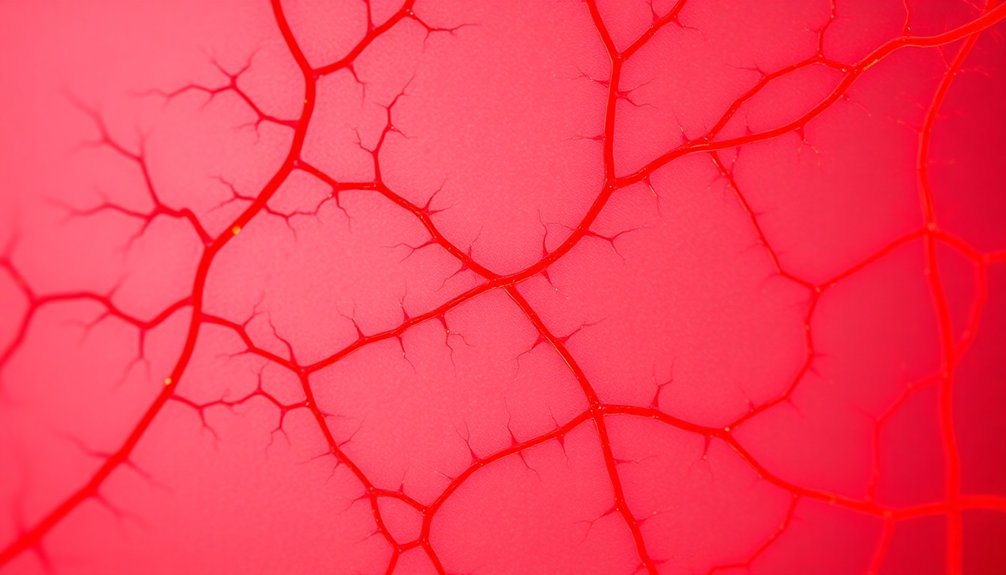
Through enhanced circulation, your body's recovery process accelerates dramatically. When you undergo red therapy, your blood vessels dilate, allowing for increased oxygen and nutrient delivery to damaged tissues.
This enhanced blood flow triggers a cascade of healing responses, from faster wound repair to reduced inflammation and improved muscle recovery.
Your body's natural healing mechanisms work more efficiently when circulation improves. The increased production of nitric oxide helps widen your blood vessels, while enhanced microcirculation guarantees that even the smallest blood vessels deliver essential nutrients to deep tissues.
You'll experience reduced swelling and improved lymphatic drainage, which are essential for ideal recovery.
- Vasodilation allows for better oxygen delivery to muscles, reducing post-workout soreness and speeding up recovery time
- Enhanced microcirculation helps repair damaged cells and tissues more efficiently, particularly in hard-to-reach areas
- Improved lymphatic flow reduces swelling and inflammation, helping you bounce back faster from injuries
You can maximize these benefits by combining red therapy with complementary approaches like exercise, massage, and proper sleep habits. This thorough approach guarantees you're giving your body the best possible environment for recovery and healing.
Future of Vascular Therapy
Three revolutionary developments are reshaping the future of vascular therapy: regenerative medicine, artificial intelligence, and advanced biotechnology.
You'll soon see personalized stem cell treatments that can grow blood vessels tailored to your specific needs, while bioresorbable stents will dissolve naturally after they've done their job.
AI's impact on vascular health can't be understated. You'll benefit from AI-driven image analysis that spots potential issues before they become serious, while predictive analytics will help your healthcare team make better decisions about your treatment path.
Advanced sensors will monitor your endothelium health and detect damage early, allowing for timely interventions.
The integration of SpiderGraft technology and synthetic vascular networks will transform how you receive treatment. These biocompatible solutions mimic your body's natural vessels, reducing complications and improving outcomes.
You'll also see the emergence of smart wearable devices that continuously monitor your cardiovascular health, providing real-time data to your healthcare providers.
Combined with 3D-printed diagnostic tools and AI-driven robotics, these innovations will make vascular treatments more precise, less invasive, and substantially more effective.
Frequently Asked Questions
Can Red Light Therapy Interact Negatively With Blood Pressure Medications?
Yes, you'll need to be cautious as blood pressure medications can increase light sensitivity and potentially cause adverse reactions. Always consult your healthcare provider before starting red light therapy while on these medications.
Does Red Light Therapy Work Differently for Smokers Versus Non-Smokers?
Yes, you'll experience reduced benefits if you smoke since smoking damages blood vessels and impairs nitric oxide production. Non-smokers typically see better results from red light therapy's vasodilation and circulatory benefits.
How Soon After Eating Should I Wait Before Doing Red Light Therapy?
You'll want to wait at least 30-45 minutes after eating before doing red light therapy. This timing helps your body properly process the meal while maximizing the therapy's blood glucose-lowering effects.
Is Red Light Therapy Safe During Pregnancy for Improving Circulation?
While red light therapy can improve circulation, you'll need to consult your healthcare provider first. Though generally safe, avoid using it on your abdomen and always wear eye protection during pregnancy sessions.
Can Combining Cold Therapy With Red Light Enhance Blood Vessel Benefits?
Yes, you'll get enhanced benefits by combining cold and red light therapy. They work together to improve circulation – cold therapy reduces inflammation while red light stimulates blood flow, leading to stronger, healthier blood vessels.
In Summary
You'll find red light therapy is a powerful tool for improving your vascular health. By boosting nitric oxide production and enhancing blood flow, you're giving your body the support it needs for stronger blood vessels and better circulation. Whether you're an athlete seeking peak performance or someone focused on long-term health, incorporating red light therapy into your routine can help build a more robust vascular system.

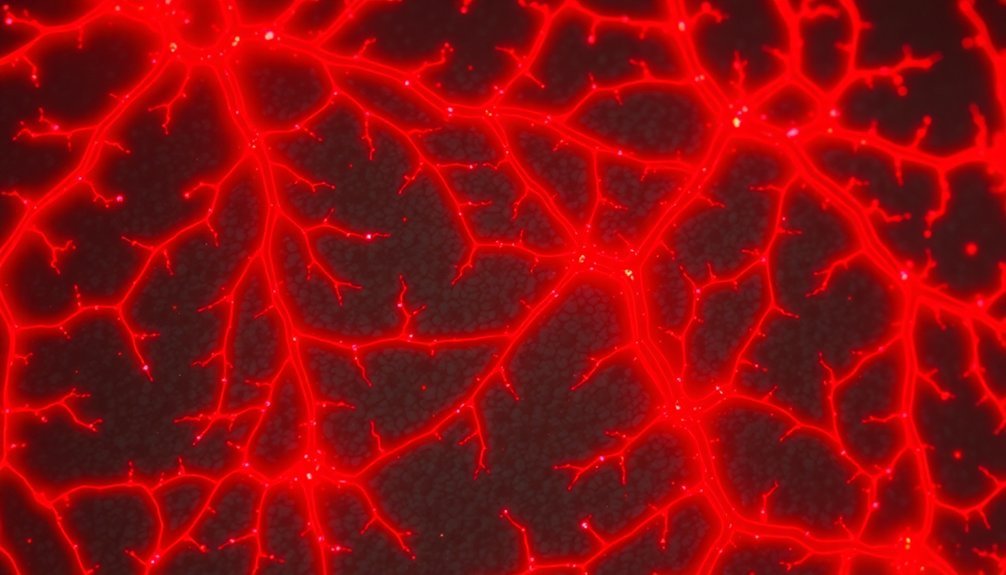



Leave a Reply